
Content created: 1997-12-26
File last modified:

The oldest work in the Confucian Canon (link) is the Yì Jīng 易经, or “Canon of Changes,” also called the Zhōu Yì 周易, or “Changes of the State of Zhōu”). (The obsolete transliteration “I Ching” remains common in English.)
The Yì Jīng provides a basis for text-based divination, and has had a surprisingly continuous respectability for about three millennia. This page is designed to provide the English reader with a sense of what is involved.
The starting point is a set of eight “trigrams” (guà 卦), each composed of three horizontal lines (yáo 爻). Each line can be continuous or broken. The continuous line ⚊ is considered to be yáng 阳. A broken one ⚋ is classified as yīn 阴.
For purposes of divination, the lines are read from the bottom of the stack to the top. For example a broken line on the bottom and two solid lines above it would be read as yīn-yáng-yáng. Each of the trigrams has a Unicode computer code, but most type fonts do not include them. For present purposes, therefore, they are represented by binary numbers, read from left to right rather than bottom to top. Broken-solid-solid (yīn-yáng-yáng) will be shown here as “011.” (The computer code is U+2634, and if your browser can display it, it looks like this: ☴) Each of the eight trigrams also has a name. The name of 011 is xùn 巽.
The logical number of combinations of three lines, yáng and yīn, is eight (000, 001, 010, 011, 100, 101, 110, 111). Each combination has a name, and each is associated with a direction, a feature of the physical world, and a quality that may be attributed to physical action. Just as the five elements are easily aligned with things that come in fives, from directions to colors to flavors, so other conventionalized associations with the eight trigrams are also usual. Here is a list in binary order with animals as an example..
| Name | Shape | Physical Tag | Dir. (Fúxī) | Quality | Animal |
|---|---|---|---|---|---|
| 1 kūn 坤 | ☷ 000 | (1) earth (2) pure yīn | N | compliant (shun 顺) | ox |
| 2 gèn 艮 | ☶ 001 | mountains | NW | stationary (zhǐ 止) | dog |
| 3 kǎn 坎 | ☵ 010 | water | W | sinking (xiàn 陷) | hog |
| 4 xùn 巽 | ☴ 011 | wind | SW | penetrating (rù 入) | cock |
| 5 zhèn 震 | ☳ 100 | thunder | NE | mobile (dòng 动) | dragon |
| 6 lí 离 | ☲ 101 | fire, light, heat | E | beautiful (lì 丽) | pheasant |
| 7 duì 兑 | ☱ 110 | water vapor | SE | pleasing (yuè 悦) | goat |
| 8 qián 乾 | ☰ 111 | (1) heaven (2) total yáng | S | strong (jiàn 健) | horse |
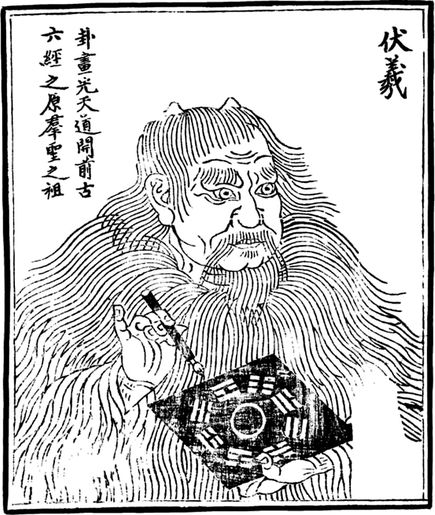
The discovery or invention of these is traditionally attributed to the legendary monarch Fúxī 伏羲 (reign 1a-1), who is said to have seen in them all the workings of the universe. He is believed to have arranged them in a circle (with the base of each trigram toward the middle). As with Chinese traditional maps, south (pure yáng) is at the top, represented by three solid lines. The woodcut picture at left below is the usual illustration of this. For convenience of English speakers it is spun around on the right to put north on top, as it is in the late dynastic woodcut at the left.
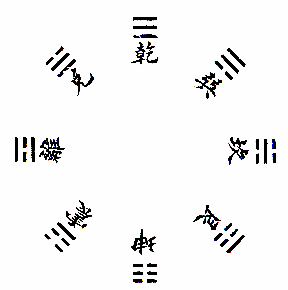
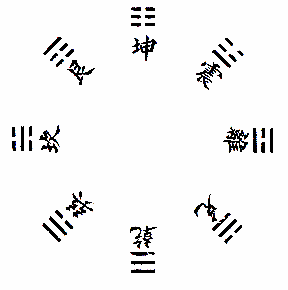
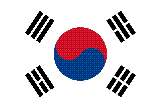
This configuration is referred to as the Fúxī arrangement or the arrangement of the Prior Heavens (Xiāntiān 先天). It is frequently associated with exorcism of malign spirits or forces, so it is found on charms and the costumes and equipment of exorcists. (An extract of it including only the four trigrams corresponding to the cardinal directions is found on the national flag of the Republic of Korea, shown at the right, although rotated 45° to fit on a flag. Challenge: Why do you think these particular four trigrams were selected? Challenge: Whether displayed horizontally or vertically, Korean flag etiquette requires that the three solid bars 111 appear in one of the top corners. Why?)
A second arrangement, referred to as that of the Posterior Heavens (Hòutiān 后天) is associated with King Wén 文王, the father King Wǔ 武王 (monarch 4b-1), the founding monarch of the Zhōu 周 dynasty.
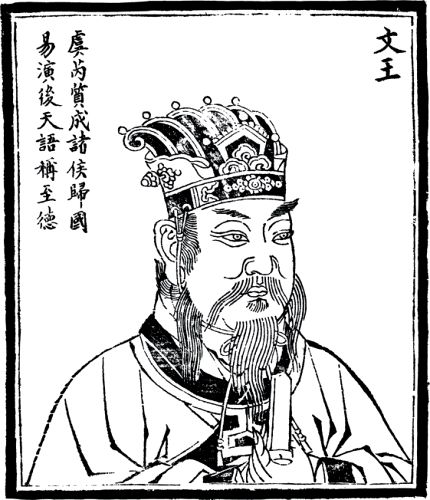
King Wén was imprisoned for many years by Mad King Zhòu 纣王 (reign 3-31), the degenerate last monarch of the Shāng 商 dynasty, and much of his time in prison was spent contemplating the trigrams, the images he could imagine in them (based on the names in the table shown above, such as “mountain” or “wind”), and the possibility that the natural world that he saw reflected in them could be used to predict the future.
King Wén's arrangement moved the qián (111 ☰) trigram from south to northwest, and dispensed with the bilateral symmetry in the Prior Heaven arrangement. His ordering is referred to as the Posterior Heavens (Hòutiān 后天) arrangement. It is used in divination, rather than exorcism.
The following charts show King Wén's arrangement at the left with the north at the top, western-style. At the right (with south at the top, Chinese-style) the two arrangements are overlaid on each other, Prior Heavens (Fúxī) in the outer ring, Posterior Heavens (King Wén) in the inner one, both with the bottoms of each trigram pointing toward the middle of the circle. Thus the Prior Heavens circle has 111 at the top (south), but the Posterior Heavens has 101 in that position.

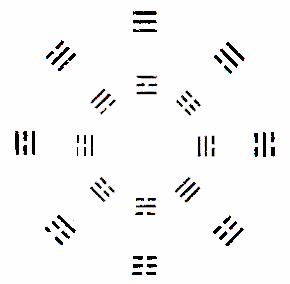
Here is the same table given above, enlarged to include King Wén's arrangement:
| Name | Shape | Physical Tag | Dir. (Fúxī) | Dir. (Wén) | Quality | Animal |
|---|---|---|---|---|---|---|
| 1 kūn 坤 | ☷ 000 | (1) earth (2) pure yīn | N | SW | compliant (shun 顺) | ox |
| 2 gèn 艮 | ☶ 001 | mountains | NW | NE | stationary (zhǐ 止) | dog |
| 3 kǎn 坎 | ☵ 010 | water | W | N | sinking (xiàn 陷) | hog |
| 4 xùn 巽 | ☴ 011 | wind | SW | SE | penetrating (rù 入) | cock |
| 5 zhèn 震 | ☳ 100 | thunder | NE | E | mobile (dòng 动) | dragon |
| 6 lí 离 | ☲ 101 | fire, light, heat | E | S | beautiful (lì 丽) | pheasant |
| 7 duì 兑 | ☱ 110 | water vapor | SE | W | pleasing (yuè 悦) | goat |
| 8 qián 乾 | ☰ 111 | (1) heaven (2) total yáng | S | NW | strong (jiàn 健) | horse |
Useful hint: It is useful to remember the difference when one looks at Chinese art. The Fúxī arrangement with the full yáng and full yīn trigrams opposite each other is normally used for exorcism. The King Wén arrangement where they are not opposite is used in divination. Fúxī will appear on charms (sometimes including embroidery on clothing); King Wén will appear on geomantic compasses and almanacs.
It is possible to place one trigram on top of another to produce a hexagram, i.e., a stack of six lines. For example, lí (101) on the bottom and gèn (001) on top would produce (reading always from the bottom) a composite hexagram 101001. Just as the number of combinations of three lines is 23=8, so the number of combinations of six lines is 26=64.
Each of the sixty-four hexagrams (tuàn 彖) has a unique name indicating its general significance (such as profit or travel or joy). It was believed that, like the hexagrams themselves, these names were assigned by King Wén, who also added a brief text (called an yì 意, “meaning” or “intention,” today usually translated “judgement”).
Each yì text was traditionally attributed to King Wén’s efforts while in prison to predict the outcome of military struggles outside.

For example, Symbol 42 (zhèn+xùn or 100011, shown at right in red) is named yì 益, “increase,” and the “judgement” text reads: “Profit in distant travel. Profit in fording a great stream.” (Lì yǒu yōuwǎng; lì shè dà chuān. 利有攸往。利涉大川。) That is all King Wén had to say about it.
Tradition holds that King Wén's son, King Wǔ (monarch 4b-1) 武王 eventually elaborated the “judgement” notes with more expansive texts referred to in English as “divinations,” called in Chinese, like the hexagrams themselves, tuàn 彖. These tuàn usually dissect the parts of the hexagram to provide a logic and the possibility of expansion of its meaning, although it is hard for most normal people today to understand how he could draw so much meaning from an individual line, broken or unbroken.
Thus in the case of Symbol 42 (100011), our continuing example here (the one in red), he tells us that the first (bottom) line (1, a solid one) means we can move without blame. The second (0, a broken one) shows us adding ten tortoise shell oracles that will confirm this and it tells us to be firm in our determination. The third line from the bottom (0, another broken one) tells us that although increase can come from what is evil, it can come without blame if we are sincere. And so on.
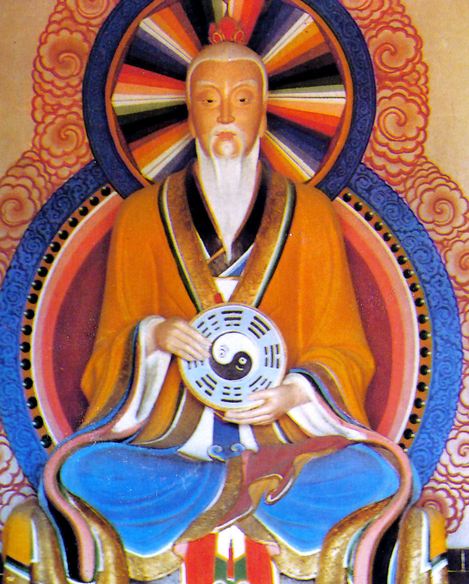
These line-by-line interpretations are nearly always included after King Wén’s spare and often ambiguous “judgements.”
In addition, many annotations by other authors trying to clarify (or justify) these interpretations are also traditionally included, some of them attributed (uncritically) to Confucius himself. These too are called tuàn (or tuànzhuàn 彖传 or in some cases xiàngzhuàn 象传) or “side-wings” (fáng 房). In the case of Symbol 42, for example, “Confucius” adds that a superior person thinks before he speaks and plans before he moves, and thus elicits the cooperation of others.
By the time Confucianism became state doctrine in the late second century BC —early in the Hàn 汉 dynasty— the hexagrams and their associated texts had worked their way into respectable Confucianism and, as noted, they make up the oldest work in the Confucian canon of all later ages under the name Yì Jīng 易经 or “Canon of Changes.” (The word “change” is used because among the tuàn are explanations that add shadow meanings created by changing the ones and zeros of the selected hexagram in various ways to amplify its message.)
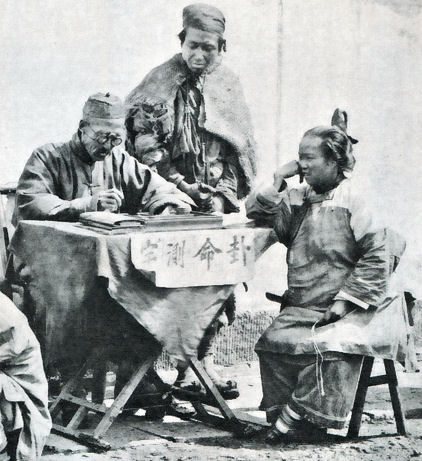
In actual use for divination, it is normal to take into consideration only one, or at most two, hexagrams for a given question, and it obviously can take considerable imagination to see the relevance of the texts associated with a selected hexagram to the question to which an answer is sought.
In practice, much of the diviner’s time is spent determining which of the 64 texts is the correct one. This is not done by reading the texts. Instead it is done in any of a number of standard ways which are, in the end, time-consuming randomizing devices.
Psychologically, it is probably the case that a means of divination is valued in proportion to the cost in time or money that it entails, so spending half an hour picking the right Yì Jīng passage endows it with an authority that spinning a dial, say, does not. (This is surely an important reason for the comparative lack of success in automated fortune-telling machines, on-line fortune-telling, downloadable fortune-telling apps, &c. They are too convenient.)
Except for the antiquity of its authority, the Yì Jīng is not significantly different from many other sets of ambiguous “tally verses” (qiānshī 签诗). Tally verses, probably often originally composed in trance, are attributed to local deities across China. They are usually in sets of 60, 64, or 100 and may be preserved (or distributed) in books, or may be printed on numbered slips of paper so that individual slips may be torn off and carried home. A believer consults them by use of correspondingly numbered tally sticks (qiān 签), the selection confirmed by use of divination blocks (bēi 杯).
Because the principal texts are typically ambiguous, just as is the Yì Jīng, such verses are often printed with brief annotations about how they apply to various problems that petitioners typically bring to a temple. Their applicability to less common problems is mediated by a competent temple attendant, called a “tally explicator” (shìqiānzhě 释签者), often quite skilled in turning an ambiguous printed prompt into sage and useful advice.
The picture at left below shows a tally set and interpretative manual published for the use of English speakers. The texts in the manual are selected and translated from different sets of tally verses originally associated with five different gods. Each is followed by an interpretation, typically a bit of homey and generic advice similar to what is found in newspaper daily horoscopes. The picture at the right shows a pair of bēi of the kind used in temples to confirm that the petitioner has drawn the correct tally. (An article I wrote about the use of bēi in Taiwan is available on this web site: Link.)

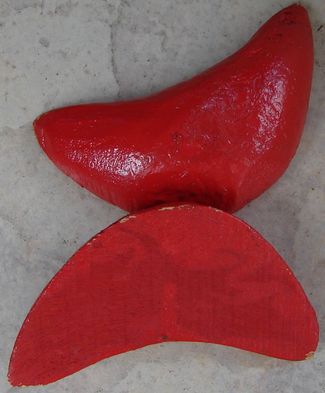
A separate article on divination is in preparation for the glossary of anthropology elsewhere on this web site. For the present, it is enough to note that divination can benefit a person
When a problem is made widely known, a whole family or community may work together in its solution, usually a beneficial result even if one believes that the divinatory advice is in fact random. Although some of the “problems” exist only because divinatory means exist to “solve” them (e.g., "Was the offering sufficient?"), others are real enough (e.g., "Should I major in anthropology?"), and we must suppose that people who bring them to temples are in fact worried about them.
* CÀI Wénhuī 蔡文輝 1981 “Táiwān Miàoyǔ Zhànguà de yīge Yánjiù.” 台灣廟宇占卦的一個研究。 (“Research into tally divination in Taiwan temples.”) IN Shèhuìxué yǔ Zhōngguó Yánjiù. 社會學與中國研究。 (Sociology and Chinese Research.) Taipei: 東大圖書公司. Pp. 127-135.
A study of the content of tally divination in southern Taiwan was undertaken in 1966 by Sociologist CÀI Wénhuī 蔡文辉. It was reprinted in a collection of his writings in 1981.* Cài and his assistants conducted 706 interviews in three major temples in Táinán 台南 city. The temples were selected for their large number of worshippers, their general fame, and the fact that they had different central cults. The study is of greatest interest for suggesting the kinds of problems that worshippers presented for solution. However it is also obvious from the results that all of the numbers could easily change over time and across China in response to a wide range of easily imagined factors, importantly including simple fashion.
The following are some of Cài’s findings:
* Comment by DKJ:
Education, especially for women, was extremely limited in Taiwan before 1945, and a modern school system instituted after that time has today become the envy of the world. Therefore these numbers could not be replicated in a similar survey now. (Even at that time, the “illiterate” people surveyed were probably mostly the older informants.) However the general correlation of low education with high use of tally divination probably still holds.
Sex of Worshippers (p. 130):
Male: 22%
Female: 78%
Age of Worshippers (p. 132):
Under 20: 4%
21-30: 19%
31-40: 34%
41-50: 21%
>50: 21%
Unknown: 1%
Completed Education Level of Worshippers* (p. 131):
University or above: 0%
Middle or High School: 4%
Elementary School: 43%
Illiterate: 49%
* Comment by DKJ:
The question referred to how well the divination addressed the problem and how helpful the advice was. Cài quite reasonably suggests (p. 134) that the outcome was probably heavily influenced by the skill of the particular tally explicators involved.
Outcome of the Divination* (p. 135):
Generally positive (hǎo 好): 54%
Generally negative (huài 坏): 18%
Ordinary (pǔtōng 普通): 38%
* Comment by DKJ:
For most purposes, there is relatively little specialization of divination among these temples, and any question can be asked in any of them. Only two of these categories seemed to vary significantly across the three temples: illness (43%-4%-13%) and Destiny (23%-59%-19%) for respectively the Xīngjì Gōng 兴济宫 (dedicated to Bǎoshēng Dàdì 保生大帝), the Tiān Tán 天坛 (dedicated to Tiāngōng 天公) and the Kāijī Wǔ Miào 开基武庙 (dedicated to Guāndì 关帝).
Nature of the Problem Presented* (p. 133):
Destiny (mìngyùn 命运): 29%
Career/workplace (shìyè 事业): 27%
Illness (jíbìnq 疾病): 17%
Marriage (hūnyīn 婚姻): 8%
Changing residence (qiānjū 迁居): 6%
Examinations (kǎoshì 考试): 3%
Making money (fācái 发财): 2%
Luck (jíxiōng 吉凶): 1%
Bearing Children (shēngyù 生育): 1%
Other (qítā 其他): 5%
Unknown (bùxiáng 不详): 2%
The content of prayers, vows, and petitions is an important approach to understanding how religion functions in people’s lives, and studies like Cài’s help to show what kinds of issues are considered both religiously significant and personally troubling. A broader survey would take account of who lives near a temple, what the public health situation is, unemployment rates, whether it is summer or winter, whether a temple serves a rural or an urban population (or a student population), and countless other variables to which such results may be expected to be responsive.
The bottom line in all of this is that tally divination is very much alive today, just as it has been throughout Chinese history, and that it is able to provide satisfying and often useful (hǎo 好) advice on the travails of daily life.